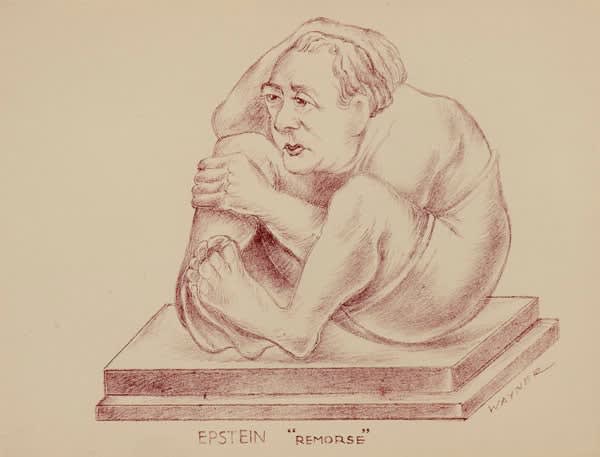Epstein, 'Remorse'
stone lithograph on paper
21 x 38
(lower right): Wayner
1987-424xxxvii
@Mark Wayner estate
Photo: Bridgeman images
Sculptor Jacob Epstein (1880-1959) was born into a Polish-Jewish family in New York City, USA in 1880 and raised in Manhattan’s multicultural Lower East Side. He began his art career...
Sculptor Jacob Epstein (1880-1959) was born into a Polish-Jewish family in New York City, USA in 1880 and raised in Manhattan’s multicultural Lower East Side. He began his art career as a teenager, sketching the urban landscape around him, which led to his first professional commission to illustrate Hutchins Hapgood’s 1902 work 'Spirit of the Ghetto'. Epstein moved to London in 1905 and was naturalised on 4 January 1911. In 1907 he received his first major British commission and created 18 nude sculptures for the facade of the British Medical Association Building (now Zimbabwe House) on the Strand. A champion of direct carving, he was also associated with the short-lived Vorticist group, co-curated the so-called 'Jewish Section', part of the Whitechapel Art Gallery's 'Review of Modern Movements', with David Bomberg in 1914, and was a co-founder of the London Group. His work often challenged prevailing notions of sexuality and beauty and favoured the non-European model. However, his portrait heads, usually cast in bronze, were always in demand. In 1933 he met with Albert Einstein for three portrait sittings, shortly after the scientist had fled Germany. During the Second World War he executed seven portrait busts for the War Artists’ Advisory Committee, was introduced to Winston Churchill, and completed his portrait bust in 1947. Some of his major public sculptures can be seen at Coventry Cathedral, Llandaff Cathedral, Hyde Park, and New College Chapel, Oxford. His statue of Field Marshal Jan Smuts was unveiled in London’s Parliament Square in 1956. Epstein died in London in 1959 and was buried in Putney Vale cemetery.
Be the first to know – Sign Up
Subscribe to our newsletter and be the first to know about everything new at Ben Uri, including the constantly evolving and expansive online content across our exhibitions, collection and research.
We value and respect your privacy. Your personal data will be kept private and processed securely, according to our Privacy Policy. If you change your mind anytime, you can unsubscribe directly when receiving a mail from us (the link will be at the bottom of the email) or contact us.
* denotes required fields
This website uses cookies to improve your experience. If you are not happy with this, you can opt-out below.


